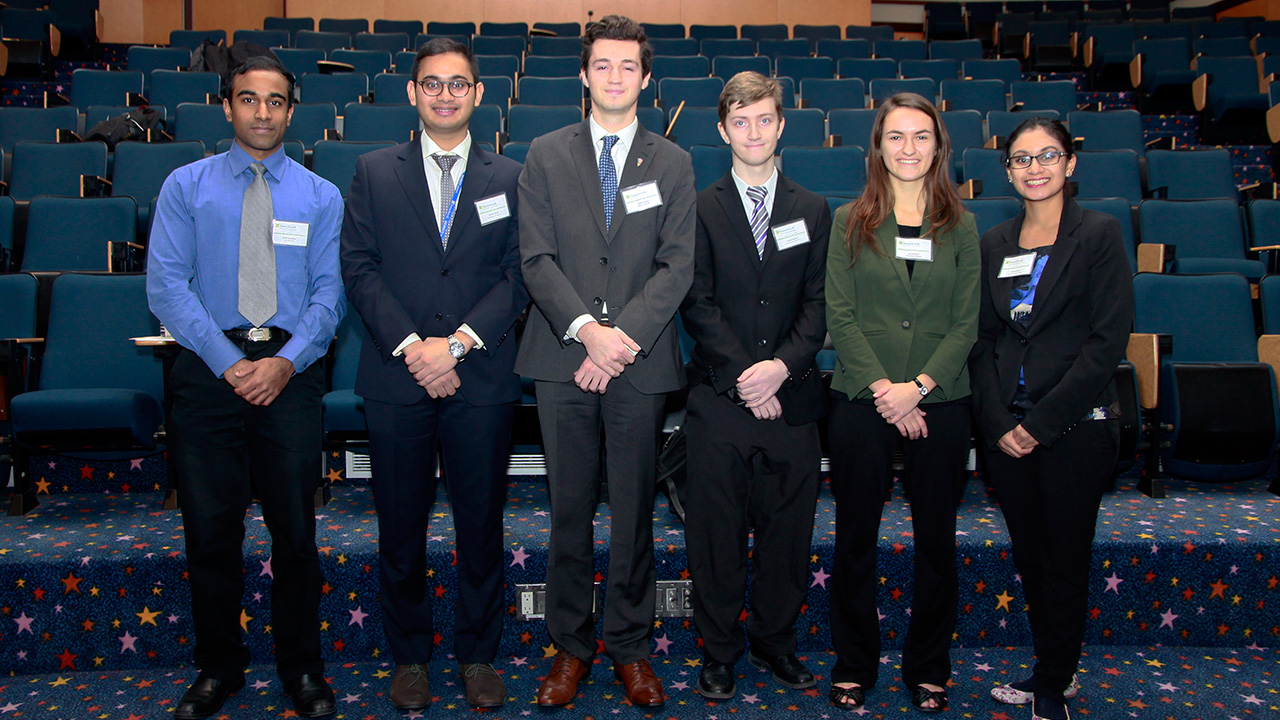Six strive for major research prize
Nidhi Juthani is the winner of the 2017 Sunnybrook Research Prize. The fourth-year chemical engineering student at the University of Waterloo won the prestigious award, along with $10,000, for her research on cell sheet engineering.
“I’m shocked. I have tuition to cover and grad school applications. I haven’t even thought about how I will use it,” says Juthani, who heard about the competition through a Facebook post and put a sticky note on her laptop as a reminder to apply.
She was among six undergraduate students from universities across Canada selected to present their research projects to scientists and trainees at the sixth annual competition held Jan. 6, 2017 at Sunnybrook Research Institute (SRI).
Juthani conducted the research during a four-month co-op internship in the lab of Dr. Joanna Aizenberg at the Wyss Institute for Biologically Inspired Engineering at Harvard University. She created a method to lift mesenchymal stem cell sheets from infused polymer surfaces while keeping the cell sheets intact and viable. The work was published in Nature Scientific Reports. Juthani is the paper’s first author and inventor for the U.S. patent application.
“The aim of this project is to first of all develop a low-cost and easy bench-top application system for cell sheet engineering. Second would be to actually further develop this field and have more people do research in it,” she says. “By making that process easier, you can push therapeutics that relate to cell sheet engineering further down the pipeline.”
Dr. Michael Julius, vice-president of research at SRI and Sunnybrook, welcomed attendees and congratulated the students on their hard work. “Today, we celebrate brilliant science at the undergraduate level. These talented, young, would-be scientists have demonstrated an impressive aptitude for a career dedicated to discovery and innovation,” he says.
The six finalists came from Alberta and Ontario. They presented projects that included developing a real-time, image-guided surgical navigation system; understanding the role of ultrasound pulse parameters at clinical frequencies; and designing a computerized, head-mounted imaging device for the early detection and monitoring of age-related macular degeneration, an eye condition that causes vision loss.
 Dr. Kullervo Hynynen presents Nidhi Juthani with the $10,000 prize for winning the 2017 Sunnybrook Research Prize. [Photo: Dr. Sheng-Kai Wu]
Dr. Kullervo Hynynen presents Nidhi Juthani with the $10,000 prize for winning the 2017 Sunnybrook Research Prize. [Photo: Dr. Sheng-Kai Wu]
Dr. Peter Burns, a senior scientist in Physical Sciences, chaired the event and was among the panel of 10 judges comprised of SRI scientists. Each finalist had 15 minutes to present his or her work and five minutes to answer questions from the judges and audience.
Marcelline Ramcharan, coordinator of the Sunnybrook Research Prize, says she is impressed each year by the number of applications submitted from a wide geographical range, the quality of research proposals and the enthusiasm of the applicants. “It’s really great to see how dedicated students can be at this level in their programs,” she says.
Faculty in SRI’s Physical Sciences platform established the national award to recognize excellence in undergraduate research and promote careers in biomedical research. The competition, open to undergraduates in their third or fourth year of study at a Canadian university, gives students the opportunity to showcase their work and see high-quality research being conducted by their peers from other institutions. Award funding comes from income generated by royalties from technology developed by SRI scientists. Each finalist who did not win received a $100 honorarium. All received travel support.
In the afternoon, students were given a tour of the labs within SRI’s Centre for Research in Image-Guided Therapeutics. The state-of-the-art facility brings together scientists and clinicians to develop new and better ways to detect, diagnose and treat complex health conditions, including cancer, diseases of the heart and brain, musculoskeletal disorders and immune deficiencies. Sunnybrook Research Institute leads in this research and was recently named Canada’s first Centre of Excellence in focused ultrasound.
Dr. Kullervo Hynynen, director of Physical Sciences, wrapped up the day with some remarks before announcing the winner. “We were really impressed this year by how good all your presentations are,” he says. “It wasn’t an easy decision for us to make. All of you are winners.”
The other finalists and their projects are as follows:
- Zachary Baum, fourth-year biomedical computing, Queen’s University: “Design, development and evaluation of a real-time, tracked, augmented reality display system for surgical navigation.”
- Nicole Bowal, third-year mechanical engineering, University of Calgary: “Lower limb kinematics and kinetics in children with cerebral palsy.”
- Shaurya Gupta,fourth-year engineering science, University of Toronto: “Structured light registration in computer-assisted navigation in spinal surgeries.”
- Samal Munidasa,third-year biophysics, York University: “Head-mounted computerized imaging technique for the detection and monitoring of age-related macular degeneration.”
- Wesley Walker, third-year nanotechnology engineering, University of Waterloo: “Contrast-enhanced ultrasound imaging with acoustically vaporized submicron droplets: the role of pulse parameters at clinical frequencies.”



